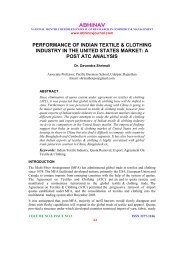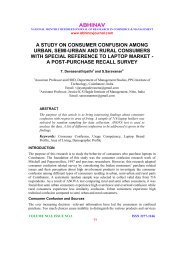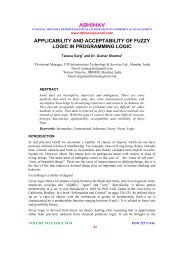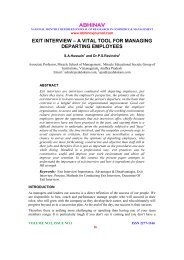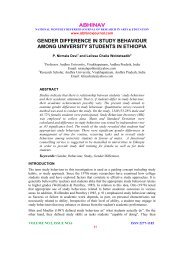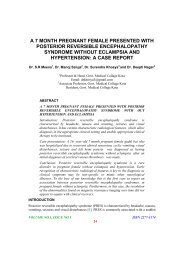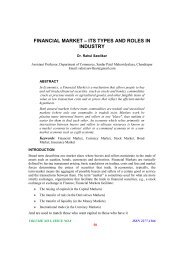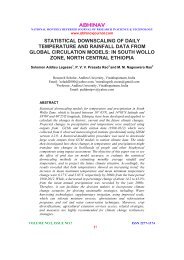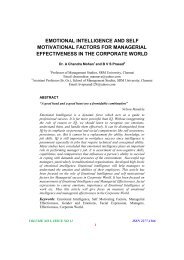Basel Iii Norms and Indian Banking - Abhinav Institute of ...
Basel Iii Norms and Indian Banking - Abhinav Institute of ...
Basel Iii Norms and Indian Banking - Abhinav Institute of ...
Create successful ePaper yourself
Turn your PDF publications into a flip-book with our unique Google optimized e-Paper software.
BASEL III NORMS AND INDIAN BANKING:<br />
ASSESSMENT AND EMERGING CHALLENGES<br />
C.S.Balasubramaniam<br />
Pr<strong>of</strong>essor, Babasaheb Gawde <strong>Institute</strong> <strong>of</strong> Management Studies, Mumbai<br />
Email: balacs2001@yahoo.co.in<br />
ABSTRACT<br />
<strong>Banking</strong> operations worldwide have undergone phenomenal changes in the<br />
last two decades since 1990s. Financial liberalization <strong>and</strong> technological<br />
innovations have created new <strong>and</strong> complex financial instruments/products<br />
have increased their role <strong>and</strong> turnover in financial markets <strong>and</strong> have<br />
rendered banking operations vulnerable to a variety <strong>of</strong> risks. The financial<br />
crisis episodes surfaced since 2006 have highlighted this paradox to a<br />
number <strong>of</strong> central banks operating in different countries <strong>and</strong> RBI <strong>and</strong> <strong>Indian</strong><br />
banking sector is no exception to this phenomenon. <strong>Basel</strong> framework has<br />
been drawn by Bank for International Settlements (BIS) in consultation with<br />
supervisory authorities <strong>of</strong> banking sector in fifteen emerging market<br />
countries with the basic objective <strong>of</strong> advocating codes <strong>of</strong> bank supervision<br />
<strong>and</strong> promoting financial stability amidst economic crises.<br />
This research paper is divided in three parts .The opening part attempts to<br />
briefly describe the changes in the banking scenario since 1991 reforms <strong>and</strong><br />
the necessity <strong>of</strong> introducing <strong>Basel</strong> III to the <strong>Indian</strong> <strong>Banking</strong> sector. Part II<br />
presents the <strong>Basel</strong> st<strong>and</strong>ards framework <strong>and</strong> explains why the transition<br />
from <strong>Basel</strong> II to <strong>Basel</strong> III norms has become necessary to bring in measures<br />
<strong>and</strong> safety st<strong>and</strong>ards which would equip the banks to become more resilient<br />
during the financial crises <strong>and</strong> prevent the banks being subject to<br />
liquidations /closures. Part III brings out a discussion on the compliance<br />
process by the <strong>Indian</strong> banks to <strong>Basel</strong> st<strong>and</strong>ards in recent period <strong>and</strong> finally,<br />
the issues <strong>and</strong> challenges faced by the <strong>Indian</strong> <strong>Banking</strong> sector are posed in<br />
the conclusion.<br />
Keywords: <strong>Basel</strong> III guidelines, New Capital Adequacy requirement,<br />
Regulatory Capital, Macro financial stability, Compliance process, Risk<br />
Management in banks<br />
INTRODUCTION<br />
Brief scenario <strong>of</strong> changes since the banking sector reforms<br />
The foundation for banking sector growth <strong>and</strong> resilience was laid with the introduction <strong>of</strong> the<br />
financial sector reforms as early as 1991, when M.Narasimham made the path breaking<br />
recommendations with focus on increased competition <strong>and</strong> prudential regulations. These<br />
VOLUME NO.1, ISSUE NO.8 ISSN 2277-1166<br />
39
ABHINAV<br />
NATIONAL MONTHLY REFEREED JOURNAL OF REASEARCH IN COMMERCE & MANAGEMENT<br />
www.abhinavjournal.com<br />
reforms resulted in comprehensive transformation <strong>of</strong> the banking sector in the economy. The<br />
reforms had a major impact on the overall efficiency <strong>and</strong> stability <strong>of</strong> the banking system.<br />
The outreach <strong>of</strong> banks increased in terms <strong>of</strong> branch /ATM presence geographically across<br />
the country <strong>and</strong> segments <strong>of</strong> the population. The balance sheets <strong>and</strong> the overall banking<br />
activities combined with financial <strong>and</strong> investment banking services grew in size <strong>and</strong> scope.<br />
The financial performance <strong>and</strong> efficiency <strong>of</strong> <strong>Indian</strong> banks improved dramatically with<br />
increased competition between public sector banks <strong>and</strong> new generation technology oriented<br />
private banks. This could be observed in the pr<strong>of</strong>itability, net interest margins, return on<br />
assets (ROA) <strong>and</strong> return on equities. (ROE) The capital position improved significantly <strong>and</strong><br />
the banks were able to bring down their non performing assets (NPA) sharply. This reform<br />
phase also revealed increased use <strong>of</strong> technology which in turn helped improve customer<br />
service.<br />
While financial stability is not explicitly stated objective under the Reserve Bank Act 1934,<br />
various measures were undertaken from time to time to strengthen the financial stability in<br />
the system which covered a wide arena. The approach has evolved from past experiences <strong>and</strong><br />
a constant interaction between the micro level supervisory processes <strong>and</strong> macroeconomic<br />
assessments. In the <strong>Indian</strong> context, the multiple indicator approach to monetary policy as<br />
well as prudent financial sector management together with a synergetic approach though<br />
close Coordination between RBI <strong>and</strong> other financial sector regulators has ensured financial<br />
stability. Some <strong>of</strong> the other policy measures include capital account management,<br />
management <strong>of</strong> systemic interconnectedness, strengthening the prudential framework,<br />
initiatives for improving <strong>and</strong> broadening the financial marketing infrastructure <strong>and</strong> a host <strong>of</strong><br />
other measures. Systemic issues arising out <strong>of</strong> interconnectedness among banks <strong>and</strong> between<br />
banks <strong>and</strong> non banking financial companies (NBFCs) <strong>and</strong> from common exposures were<br />
addressed by prudential limits on aggregate interbank liabilities as a proportion <strong>of</strong> banks’ net<br />
worth, restricting access to uncollateralized funding market to banks <strong>and</strong> primary dealers<br />
with caps on both borrowing <strong>and</strong> lending, increasingly subjecting NBFCs to contain<br />
regulatory arbitrage. The other noticeable aspect regarding policy measures has been the<br />
innovative use <strong>of</strong> countercyclical policies to address the pro-cyclicality issues. The counter<br />
cyclical policies were introduced as early as 2004 by using time varying sectoral risk<br />
weights <strong>and</strong> provisioning, though RBI had used them sporadically even earlier. These<br />
unconventional measures taken in response to emerging risks are now widely acknowledged<br />
to have played a significant role in protecting the <strong>Indian</strong> Financial system from key<br />
vulnerabilities.<br />
<strong>Basel</strong> st<strong>and</strong>ards Framework<br />
Generally, the adoption <strong>of</strong> <strong>Basel</strong> st<strong>and</strong>ards is to be viewed in the context <strong>of</strong> regulatory<br />
approach to bank supervision by the central bank <strong>of</strong> the country <strong>and</strong> the incentives system<br />
for the banks to improve their risk measurement procedures. It also takes cognizance <strong>of</strong> the<br />
fact that the new technological innovations in information technology have revolutionized<br />
the banking operations <strong>and</strong> the market practices have altered substantially since the<br />
introductory period <strong>of</strong> <strong>Basel</strong> st<strong>and</strong>ards .Consequently, <strong>Basel</strong> st<strong>and</strong>ards envisage a change in<br />
the oversight function <strong>of</strong> the central bank as a regulatory body over the commercial banks<br />
operating in the country <strong>and</strong> the capital adequacy requirements <strong>of</strong> the banks.<br />
VOLUME NO.1, ISSUE NO.8 ISSN 2277-1166<br />
40
ABHINAV<br />
NATIONAL MONTHLY REFEREED JOURNAL OF REASEARCH IN COMMERCE & MANAGEMENT<br />
www.abhinavjournal.com<br />
Rapid transformation <strong>of</strong> financial system around the globe has brought sweeping changes in<br />
the banking sector across the countries. Though new avenues <strong>and</strong> opportunities have been<br />
opened up for augmenting the revenue generation for banks, yet new processes <strong>and</strong><br />
technological progress has exposed the banks to higher risk. Therefore, the need was felt<br />
for strengthening the soundness <strong>and</strong> stability <strong>of</strong> banks <strong>and</strong> to protect the depositors <strong>and</strong> the<br />
financial system from disastrous developments which could threaten the banks solvency.<br />
<strong>Basel</strong> Committee on <strong>Banking</strong> Supervision (BCBS) under the auspices <strong>of</strong> Bank for<br />
International Settlements (BIS) took initiative putting in place adequate safeguards against<br />
bank failure with central banks across the globe.<br />
The first initiative from BIS can be identified with <strong>Basel</strong> I Accord with over 100 central<br />
banks in different countries accepting the framework stipulated by agreement. The accord<br />
provided a framework for fair <strong>and</strong> reasonable degree <strong>of</strong> consistency in the capital st<strong>and</strong>ards<br />
in different countries, on a shared definition <strong>of</strong> capital. Although these st<strong>and</strong>ards were not<br />
legally binding, they have made substantial <strong>and</strong> significant impact on banking supervision in<br />
general, <strong>and</strong> bank capital provisioning <strong>and</strong> adequacy in particular. However, <strong>Basel</strong> I<br />
comprised <strong>of</strong> some rigidities, as it did not discriminate between different levels <strong>of</strong> risks. As a<br />
result, a loan to an established corporate borrower was considered as risky as a loan to a new<br />
business. .So all loans given to corporate borrowers were subject to the same capital<br />
requirements, without taking into account the ability <strong>of</strong> the counterparties to repay. It also<br />
did not take cognizance <strong>of</strong> the credit rating, credit history <strong>and</strong> corporate governance structure<br />
<strong>of</strong> all corporate borrowers. Moreover, it did not adequately address the risk involved in<br />
increasing the use <strong>of</strong> financial innovations like securitization <strong>of</strong> assets <strong>and</strong> derivatives <strong>and</strong><br />
credit risk inherent in these developments. The important category <strong>of</strong> risk i.e., operational<br />
risk also was not given the attention it deserved.<br />
<strong>Basel</strong> II-The New Capital Adequacy Framework<br />
Recognizing the need for a more comprehensive, broad based <strong>and</strong> flexible framework , <strong>Basel</strong><br />
committee proposed an improved version in 1999, which provides for better alignment <strong>of</strong><br />
regulatory capital with underlying risk <strong>and</strong> also addresses the risk arising from financial<br />
innovation thereby contributing to enhanced risk management <strong>and</strong> control. This sophisticated<br />
<strong>and</strong> superior framework was formally endorsed by central bank governors <strong>and</strong> heads <strong>of</strong><br />
banking supervisory authorities <strong>of</strong> various countries on June 26, 2004 under the name<br />
“International Convergence <strong>of</strong> Capital Measurement <strong>and</strong> Capital St<strong>and</strong>ards “popularly<br />
known as <strong>Basel</strong> II or New <strong>Basel</strong> Capital Accord. This new set <strong>of</strong> international st<strong>and</strong>ards<br />
requires banks to maintain minimum level <strong>of</strong> capital, to ensure that they can meet their<br />
obligations, cover unexpected losses <strong>and</strong> improve public confidence. <strong>Basel</strong> II captures the<br />
risk on a consolidated basis for internationally active banks <strong>and</strong> attempts to ensure that<br />
capital recognized, set aside in capital adequacy measures <strong>and</strong> provide adequate protection to<br />
depositors. It brings into focus the contemporary risk management techniques <strong>and</strong> seeks to<br />
establish a more risk responsive linkage between the bank operations <strong>and</strong> their capital<br />
requirements. It also provides strong incentive to banks to upgrade their risk management<br />
st<strong>and</strong>ards. The accord is a cornerstone <strong>of</strong> the current international financial architecture. Its<br />
overriding goal is to promote safety <strong>and</strong> soundness in the international financial system. The<br />
provisioning <strong>of</strong> adequate capital cushion is central to this goal <strong>and</strong> the committee ensures<br />
that new framework maintains the overall level <strong>of</strong> capital currently in the banking system.<br />
VOLUME NO.1, ISSUE NO.8 ISSN 2277-1166<br />
41
ABHINAV<br />
NATIONAL MONTHLY REFEREED JOURNAL OF REASEARCH IN COMMERCE & MANAGEMENT<br />
www.abhinavjournal.com<br />
The advocates <strong>of</strong> <strong>Basel</strong> II believe that creating such an international st<strong>and</strong>ard can help to<br />
protect the international financial system from various types <strong>of</strong> financial <strong>and</strong> operational<br />
risks that banks may encounter. It also attempts to set up such rigorous risk <strong>and</strong> capital<br />
management requirements to ensure that banks hold sufficient capital reserves appropriate to<br />
the risk the bank exposes itself through its lending <strong>and</strong> investment activities.<br />
The objectives <strong>of</strong> the new <strong>Basel</strong> accord as enunciated by BIS are fivefold:<br />
1. Promoting safety <strong>and</strong> soundness <strong>of</strong> financial system<br />
2. Enhance competitive equality<br />
3. Greater sensitivity to the degree <strong>of</strong> risk involved in banking positions ,activities<br />
4. Constitute a more comprehensive approach to addressing risk <strong>and</strong><br />
Focus on internationally active banks, with capability <strong>of</strong> being applicable the banks with<br />
varying level <strong>of</strong> complexity <strong>and</strong> supervision.<br />
Structure <strong>of</strong> <strong>Basel</strong> II<br />
Pillar I<br />
Minimum Capital<br />
Requirement<br />
Pillar II<br />
Supervisory Review<br />
Process<br />
Pillar III<br />
Market Discipline<br />
The structure <strong>of</strong> <strong>Basel</strong> II framework has its foundation on three mutually reinforcing pillars<br />
(as shown in the above diagram ) that allow banks <strong>and</strong> bank supervisors to evaluate properly<br />
the various risks that banks face <strong>and</strong> realign regulatory capital more closely with inherent<br />
risks . These three pillars are discussed as under:<br />
Pillar I: Minimum Capital requirement<br />
The first pillar <strong>of</strong> <strong>Basel</strong> II deals with maintenance <strong>of</strong> regulatory capital, i.e. minimum capital<br />
required by banks as per their risk pr<strong>of</strong>ile. As in <strong>Basel</strong> I, <strong>Basel</strong> II also has same provisions<br />
relating to regulatory capital requirements i.e. 8 % Capital Adequacy Ratio (CAR). CAR<br />
under <strong>Basel</strong> II is the ratio <strong>of</strong> Regulatory Capital to risk weighted assets which signifies the<br />
amount <strong>of</strong> regulatory capital to be maintained by banks to guard against various risks<br />
inherent in banking system.<br />
Capital Adequacy Ratio =<br />
Total Regulatory Capital (Tier I + Tier II + Tier III)<br />
Risk weighted Assets (Credit risk + Market risk+ Operational risk)<br />
The risks covered under CAR in <strong>Basel</strong> II are credit risk, market risk <strong>and</strong> operational risk<br />
.Pillar I focuses on new approaches for calculating minimum capital requirements under<br />
credit risk, market risk <strong>and</strong> operational risk vary from simple to sophisticated <strong>and</strong> allow bank<br />
supervisors to choose an approach that seems most appropriate according to their risk<br />
pr<strong>of</strong>ile, activities <strong>and</strong> internal control.<br />
VOLUME NO.1, ISSUE NO.8 ISSN 2277-1166<br />
42
ABHINAV<br />
NATIONAL MONTHLY REFEREED JOURNAL OF REASEARCH IN COMMERCE & MANAGEMENT<br />
www.abhinavjournal.com<br />
Pillar II: Supervisory Review<br />
The Second Pillar <strong>of</strong> <strong>Basel</strong> II provides key principles for supervisory review, risk<br />
management guidance <strong>and</strong> supervisory transparency <strong>and</strong> accountability as under:<br />
Banks should have a process for assessing their overall capital adequacy in relation<br />
to their risk pr<strong>of</strong>ile <strong>and</strong> a strategy for maintaining their capital levels.<br />
Supervisors should review <strong>and</strong> evaluate banks’ internal capital adequacy<br />
assessments <strong>and</strong> strategies, as well as their ability to monitor <strong>and</strong> ensure their<br />
compliance with regulatory capital ratios <strong>and</strong> should take appropriate action if they<br />
are not satisfied with the result <strong>of</strong> this process.<br />
Supervisors should expect banks to operate above the minimum regulatory capital<br />
ratios.<br />
Supervisors should intervene at an early stage to prevent capital from declining<br />
below benchmark level.<br />
Pillar II cast responsibility on the supervisors to exercise best ways to manage the risks<br />
specific to that bank <strong>and</strong> also to review <strong>and</strong> validate banks risk measurement modes.<br />
All the supervisors should evaluate the activities <strong>and</strong> risk pr<strong>of</strong>iles <strong>of</strong> individual banks to<br />
determine whether those organizations should hold higher levels <strong>of</strong> capital than the<br />
minimum requirements <strong>and</strong> to see whether is any need for remedial action to ensure that<br />
each financial institution adopts effective internal processing for risk management.<br />
Pillar III: Market Discipline<br />
The objective <strong>of</strong> Pillar III is to improve market discipline through effective public disclosure<br />
to complement requirements under Pillar I <strong>and</strong> Pillar II. Pillar III relates to periodical<br />
disclosures to regulators, board <strong>of</strong> bank <strong>and</strong> market about various parameters which indicate<br />
risk pr<strong>of</strong>ile <strong>of</strong> the bank. It introduces substantial new public disclosure requirements <strong>and</strong><br />
allows market participants to analyze key pieces <strong>of</strong> information on the scope <strong>of</strong> application,<br />
risk exposures, risk assessment <strong>and</strong> management processes <strong>and</strong> hence the capital adequacy <strong>of</strong><br />
the institution. The disclosures provided under Pillar III must fulfill the criteria <strong>of</strong><br />
comprehensiveness, relevance, timeliness, reliability, comparability <strong>and</strong> materiality <strong>of</strong><br />
disclosure to enable the interested parties to make informed decision about the bank.<br />
The Three pillars <strong>of</strong> <strong>Basel</strong> II framework provides a kind <strong>of</strong> “triple protection “ by<br />
encompassing three complementary approaches that work together towards ensuring the<br />
capital adequacy <strong>of</strong> institutional practices prevalent in the banks .Taken individually each<br />
pillar has its merits ,but they are even more efficient when they are synergized in a common<br />
framework.<br />
Transition from <strong>Basel</strong> II to <strong>Basel</strong> III in a global perspective<br />
<strong>Basel</strong> III is the regulatory response to the causes <strong>and</strong> consequences <strong>of</strong> global financial<br />
crisis. From the macroeconomic perspective, the global financial crisis has been attributed to<br />
the persistence <strong>of</strong> global imbalances. It is <strong>of</strong>ten said that the solution to a previous crisis<br />
becomes the cause for the next crisis. The previous crisis was the Asian crisis <strong>of</strong> 1997-98 <strong>and</strong><br />
one <strong>of</strong> the important lessons learnt by Asian countries was to build a war chest <strong>of</strong> foreign<br />
VOLUME NO.1, ISSUE NO.8 ISSN 2277-1166<br />
43
ABHINAV<br />
NATIONAL MONTHLY REFEREED JOURNAL OF REASEARCH IN COMMERCE & MANAGEMENT<br />
www.abhinavjournal.com<br />
exchange reserves to fight against the attack <strong>of</strong> the country’s currency. Therefore ,Asia <strong>and</strong><br />
in particular ,China <strong>and</strong> some other emerging economies produced goods at a cheaper rate<br />
<strong>and</strong> pursued a policy <strong>of</strong> export- led growth <strong>and</strong> accumulated huge foreign exchange reserves.<br />
As a corollary, the USA <strong>and</strong> Europe consumed that produce <strong>and</strong> became net importers .The<br />
foreign exchange reserves accumulated by Asian <strong>and</strong> other emerging economies were<br />
necessarily to be invested in advanced economies which have deep markets. The huge<br />
amount <strong>of</strong> capital that flowed from the emerging economies, depressed yields in the financial<br />
markets <strong>of</strong> advanced economies. In the ‘search <strong>of</strong> yield’ to improve returns on investment<br />
market players indulged in financial innovation <strong>and</strong> engineering. They developed structured<br />
financial products like securitization <strong>and</strong> re-securitization based on sub-prime mortgage<br />
backed securities (MBS), collateralized debt obligations (CDOs) <strong>and</strong> CDO squared etc.<br />
Credit default swaps (CDS) were also used to create synthetic structures which increased<br />
their illiquidity <strong>and</strong> complexity. Without realizing the inherent risks created by these<br />
features, securitizations continued to grow leaps <strong>and</strong> bounds leading to the spiraling <strong>of</strong> subprime<br />
lending with impending disastrous consequences.<br />
At the micro level, the business models <strong>of</strong> banks <strong>and</strong> financial institutions also were causal<br />
to the crisis. The over reliance on financial innovation /securitization type instruments did<br />
not create any incentive for banks to better appraisal <strong>and</strong> supervision <strong>of</strong> such mortgages.<br />
Their reliance on wholesale funding markets created gaps in liquidity risk management.<br />
Short term funds were used for creating long term assets. The availability <strong>of</strong> plenty <strong>and</strong><br />
cheap funds encouraged banks to be highly leveraged, that too, by borrowing short term<br />
funds. The crisis has also been attributed to the inadequate corporate governance <strong>and</strong><br />
inappropriate compensation system for senior management in the banks.<br />
<strong>Basel</strong> III :Post crisis, the global initiatives to strengthen the financial regulatory system are<br />
driven by the leadership <strong>of</strong> G 20 under the auspices <strong>of</strong> Financial Stability Board (FSB) <strong>and</strong><br />
the <strong>Basel</strong> Committee on <strong>Banking</strong> Supervision (BCBS) .Immediately after the crisis, the<br />
<strong>Basel</strong> Committee , in July 2009 came out with certain measures also called enhancement to<br />
<strong>Basel</strong> II or <strong>Basel</strong> II.5 to plug the loopholes in its capital rules ,which were exploited to<br />
arbitrage capital by parking certain banking book positions in the trading book which<br />
required less capital . The <strong>Basel</strong> committee published its <strong>Basel</strong> III rules in December 2010.<br />
Learning the lessons from the crisis, the objectives <strong>of</strong> <strong>Basel</strong> III have been to minimize the<br />
probability <strong>of</strong> recurrence <strong>of</strong> a crisis <strong>of</strong> such magnitude. Towards this end, the <strong>Basel</strong> III has<br />
set its objectives to improve the shock absorbing capacity <strong>of</strong> each <strong>and</strong> every individual bank<br />
as the first order <strong>of</strong> defence <strong>and</strong> in the worst case scenario, if it is inevitable that one or a few<br />
banks to fail . <strong>Basel</strong> III has measures to ensure that the banking system as a whole does not<br />
crumble <strong>and</strong> its spill-over impact on the real economy is minimized. <strong>Basel</strong> III has in effect,<br />
some micro –prudential elements so that risk is contained in each individual institution <strong>and</strong><br />
macro prudential overlay that will ‘lean against the wind ‘to take care <strong>of</strong> issues relating to the<br />
systemic crisis. The <strong>Basel</strong> III framework sets out higher <strong>and</strong> better quality capital, enhanced<br />
risk coverage, the introduction <strong>of</strong> a leverage ratio as a back-stop to the risk-based<br />
requirement, measures to promote the buildup <strong>of</strong> capital that can be drawn down in times <strong>of</strong><br />
stress <strong>and</strong> the introduction <strong>of</strong> compliance to global liquidity st<strong>and</strong>ards. The following charts<br />
explain the various components <strong>of</strong> <strong>Basel</strong> III:<br />
VOLUME NO.1, ISSUE NO.8 ISSN 2277-1166<br />
44
ABHINAV<br />
NATIONAL MONTHLY REFEREED JOURNAL OF REASEARCH IN COMMERCE & MANAGEMENT<br />
www.abhinavjournal.com<br />
VOLUME NO.1, ISSUE NO.8 ISSN 2277-1166<br />
45
ABHINAV<br />
NATIONAL MONTHLY REFEREED JOURNAL OF REASEARCH IN COMMERCE & MANAGEMENT<br />
www.abhinavjournal.com<br />
High<br />
The extent to which<br />
the risk is quantifiable<br />
Credit risk<br />
Market risk<br />
Controllable<br />
risks<br />
Operational risk<br />
Controllability depends on<br />
measurement developments <strong>and</strong><br />
the development <strong>of</strong> markets<br />
Low<br />
Legal risk<br />
Strategic risk<br />
Non-<br />
Controllable<br />
risks<br />
Low High the extent to which the risk is quantifiable<br />
A Cognitive Mapping <strong>of</strong> Risks can be drawn as above, to illustrate the extent to which the<br />
various risks which are faced by the banks can be classified. Risk management in banks has<br />
been gaining ground for last two decades <strong>and</strong> the financial crisis <strong>of</strong> 2008 has led to persistent<br />
calls for experienced full time oversight on enterprise wide risks as described. All banks are<br />
now required to have an internal department directly reporting to the Chief Executive <strong>of</strong>ficer<br />
<strong>and</strong> Managing Director for the Risk management activity.<br />
VOLUME NO.1, ISSUE NO.8 ISSN 2277-1166<br />
46
ABHINAV<br />
NATIONAL MONTHLY REFEREED JOURNAL OF REASEARCH IN COMMERCE & MANAGEMENT<br />
www.abhinavjournal.com<br />
As explained above, the key elements in <strong>Basel</strong> III include the following:<br />
1. The definition <strong>of</strong> capital made more stringent, capital buffers introduced, <strong>and</strong> loss<br />
absorptive capacity <strong>of</strong> Tier I <strong>and</strong> Tier II capital instrument <strong>of</strong> internationally active<br />
banks proposed to be enhanced<br />
2. Forward looking provisioning prescribed<br />
3. Modifications made in counterparty credit risk weights<br />
4. New parameter <strong>of</strong> leverage ratio introduced<br />
5. Global liquidity st<strong>and</strong>ard prescribed<br />
VOLUME NO.1, ISSUE NO.8 ISSN 2277-1166<br />
47
ABHINAV<br />
NATIONAL MONTHLY REFEREED JOURNAL OF REASEARCH IN COMMERCE & MANAGEMENT<br />
www.abhinavjournal.com<br />
The proposed <strong>Basel</strong> III guidelines seek to enhance the minimum core capital (after stringent<br />
deductions) introduce a capital conservation buffer (with defined triggers) <strong>and</strong> prescribe a<br />
countercyclical buffer (to be built in times <strong>of</strong> excessive credit growth at the national level)<br />
Capital Conservation buffer – The <strong>Basel</strong> Committee suggests that a new buffer <strong>of</strong> 2.5 % <strong>of</strong><br />
risk weighted assets (RWA) over the minimum capital requirement <strong>of</strong> core capital<br />
requirement <strong>of</strong> 4.5 % be created by banks. Although the Committee does not view the<br />
capital conservation buffer as the new minimum st<strong>and</strong>ard , considering the restrictions<br />
imposed on banks <strong>and</strong> also because <strong>of</strong> the reputation issues, 7 % is likely become the new<br />
minimum capital requirement.<br />
The main purpose <strong>of</strong> the proposed capital conservation buffer is two-fold:<br />
1. It can be dipped into in times <strong>of</strong> stress to meet the minimum regulatory requirement<br />
on core capital<br />
2. Once accessed, certain triggers would get activated ,conserving the internally<br />
generated capital .This would happen as in this scenario ,the bank would be<br />
restrained in using its earnings to make the discretionary payouts (e.g. dividends,<br />
share buybacks <strong>and</strong> discretionary bonus)<br />
Countercyclical buffer – The <strong>Basel</strong> committee has suggested a countercyclical buffer<br />
constituting <strong>of</strong> equity or fully loss absorbing capital could be fixed by the Central bank upon<br />
the constituent commercial banks once a year , <strong>and</strong> the buffer could range from 0 to 2.5 % <strong>of</strong><br />
RWA depending on the changes in credit to GDP ratio. The primary objective <strong>of</strong> having the<br />
Counter cyclical buffer is to protect the banking sector from system wide risks arising out <strong>of</strong><br />
excessive aggregate credit growth. This could be achieved through a pro cyclical build up <strong>of</strong><br />
the buffer in good times. Typically, excessive credit growth could lead to the requirement for<br />
building up a higher countercyclical buffer; however the requirement could reduce in times<br />
<strong>of</strong> stress, thereby releasing the capital for absorption <strong>of</strong> losses or for protection <strong>of</strong> banks<br />
against the impact <strong>of</strong> potential problems.<br />
The Compliance process <strong>of</strong> <strong>Indian</strong> Banks to <strong>Basel</strong> III<br />
The minimum capital for common equity, the highest form <strong>of</strong> loss absorbing capital, will be<br />
raised from the current 2% level, before the application <strong>of</strong> regulatory adjustments to 4.5%,<br />
after the application <strong>of</strong> regulatory adjustments. This increase will be phased in to apply from<br />
Jan 1, 2013. In addition to the above, the committee recommended a 2.5% <strong>of</strong> additional core<br />
equity capital as a conservation buffer above the regulatory minimum taking the aggregate<br />
minimum core equity required to 7%. The conservation buffer is also phased in to apply<br />
from Jan 1, 2016 <strong>and</strong> will come into full effect from Jan 1, 2017.<br />
Certain regulatory deductions (material holdings, deferred tax assets, mortgage servicing<br />
rights etc) that are currently applied to tier 1 capital <strong>and</strong>/or tier 2 capital or treated as RWA<br />
will now be deducted from Core equity capital. This will also be progressively phased in<br />
over a five year period commencing 2014.<br />
VOLUME NO.1, ISSUE NO.8 ISSN 2277-1166<br />
48
ABHINAV<br />
NATIONAL MONTHLY REFEREED JOURNAL OF REASEARCH IN COMMERCE & MANAGEMENT<br />
www.abhinavjournal.com<br />
Phasing-in effect:<br />
Minimum core<br />
equity<br />
Conservation<br />
buffer<br />
Total core<br />
equity<br />
Min. total<br />
capital incl.<br />
buffer<br />
Phasing in <strong>of</strong><br />
other<br />
deductions<br />
from core T1<br />
Counter<br />
cyclical buffer<br />
2013 2014 2015 2016 2017 2018 2019<br />
3.5% 4.0% 4.5% 4.5% 4.5% 4.5% 4.5%<br />
.625% 1.25% 1.875% 2.5%<br />
3.5% 4.0% 4.5% 5.125% 5.75% 6.375% 7.0%<br />
8.0% 8.0% 8.0% 8.625% 9.25% 9.875% 10.5%<br />
20% 40% 60% 80% 100% 100%<br />
In addition the regulator can specify a counter cyclical buffer <strong>of</strong><br />
up to 2.5% <strong>of</strong> fully loss absorbing capital for macro prudential<br />
objectives<br />
Regulatory buffers, provisions, <strong>and</strong> cyclicality <strong>of</strong> the minimum<br />
The capital conservation buffer should be available to absorb banking sector losses<br />
conditional on a plausibly severe stressed financial <strong>and</strong> economic environment. The<br />
countercyclical buffer would extend the capital conservation range during periods <strong>of</strong> excess<br />
credit growth, or other indicators deemed appropriate by supervisors for their national<br />
contexts. Both buffers could be run down to absorb losses during a period <strong>of</strong> stress.<br />
Deductions from Core Tier 1<br />
Minority interest - The excess capital above the minimum <strong>of</strong> a subsidiary that is a<br />
bank will be deducted in proportion to the minority interest share.<br />
Investments in other financial institutions - The gross long positions may be<br />
deducted net <strong>of</strong> short <strong>and</strong> the proposals now include an underwriting exemption.<br />
Minority interest in a banking subsidiary is strictly excluded from the parent bank’s common<br />
equity if the parent bank or affiliate has entered into any arrangements to fund directly or<br />
indirectly minority investment in the subsidiary whether through an SPV or through another<br />
vehicle or arrangement.<br />
Other deductions<br />
The other deductions from Common Equity Tier 1 are: goodwill <strong>and</strong> other intangibles<br />
(excluding Mortgage Servicing Rights), Deferred Tax Assets, investments in own shares,<br />
other investments in financial institutions, shortfall <strong>of</strong> provision to expected losses, cash flow<br />
hedge reserve, cumulative changes in own credit risk <strong>and</strong> pension fund assets.<br />
The following items may each receive limited recognition when calculating the common<br />
equity component <strong>of</strong> Tier 1, with recognition capped at 10% <strong>of</strong> the bank’s common equity<br />
component:<br />
VOLUME NO.1, ISSUE NO.8 ISSN 2277-1166<br />
49
ABHINAV<br />
NATIONAL MONTHLY REFEREED JOURNAL OF REASEARCH IN COMMERCE & MANAGEMENT<br />
www.abhinavjournal.com<br />
Significant investments in the common shares <strong>of</strong> unconsolidated financial<br />
institutions (banks, insurance <strong>and</strong> other financial entities). “Significant” means more<br />
than 10% <strong>of</strong> the issued share capital;<br />
Mortgage servicing rights (MSRs); <strong>and</strong><br />
Deferred tax assets (DTAs) that arise from timing differences.<br />
A bank must deduct the amount by which the aggregate <strong>of</strong> the three items above exceeds<br />
15% <strong>of</strong> its common equity component <strong>of</strong> Tier 1.<br />
With the RBI flagging <strong>of</strong>f the implementation <strong>of</strong> <strong>Basel</strong> III guidelines, <strong>Indian</strong> banks have to<br />
plan for more capital in the years ahead. They are well placed to meet the higher capital<br />
requirements <strong>and</strong> can strengthen their competitive positions vis –a vis international banks –<br />
provided the government can deliver on its own responsibilities towards public sector banks.<br />
The RBI has set a more dem<strong>and</strong>ing schedule for <strong>Basel</strong> III implementation than the Bank for<br />
International Settlements. The BIS has set the deadline for the full implementation as 2019.<br />
The RBI would like the <strong>Indian</strong> banks to comply by 2017.<br />
CONCLUSIONS<br />
<strong>Basel</strong> st<strong>and</strong>ards, by <strong>and</strong> large, were an outcome <strong>of</strong> international cooperation among<br />
central banks on the face <strong>of</strong> indiscriminate cross –border bank lending <strong>and</strong> debt<br />
repudiation from certain debtor countries. India had always set an example in<br />
implementing these st<strong>and</strong>ards, but the compliance was gradual <strong>and</strong> easy –paced, so<br />
as not to disrupt the banking system. The compliance levels were relaxed from time<br />
to time to accommodate even the weakest link in the banking chain. The idea was to<br />
enable the entire system to adapt these st<strong>and</strong>ards over a fixed time line in a way that<br />
the overall investor response <strong>and</strong> the capital market in the economy is ready for the<br />
huge resource mobilization requirements posed by the compliance by the <strong>Indian</strong><br />
banks . However, the real issue is now whether the banks would be able to raise<br />
funds from the capital market when the investors are rather wary about the<br />
performance <strong>and</strong> returns from the banks /industries in general in the context <strong>of</strong> a<br />
general slowdown in industries coupled with inflation prevailing in the economy.<br />
Following the debacle <strong>of</strong> new <strong>and</strong> innovative instruments, there is a need to<br />
assimilation <strong>and</strong> watch than creating an overlay <strong>and</strong> urge by RBI to expect all the<br />
<strong>Indian</strong> Banks to comply with <strong>Basel</strong> III st<strong>and</strong>ards in hurry ,even before the full<br />
compliance with <strong>Basel</strong> II by some weak banks in the <strong>Indian</strong> economy. Before the<br />
onslaught <strong>of</strong> the global financial crisis originating from the west, even the US <strong>and</strong><br />
Europe were not seriously concerned about compliance with <strong>Basel</strong> norms. Now, the<br />
US <strong>and</strong> Europe are forced to do so, due to the international pressure. Given the<br />
above background, it is rather surprising that RBI would expect the <strong>Indian</strong> banks to<br />
be ready to comply with <strong>Basel</strong> st<strong>and</strong>ards so early by March 2017, earlier than the<br />
2019 time frame laid down in the original <strong>Basel</strong> III framework.<br />
Risk management in banks is abstract <strong>and</strong> analytical activity that draws heavily on<br />
advances in statistics <strong>and</strong> financial economics. But the pr<strong>of</strong>essionalization <strong>of</strong> the<br />
field ‘is at an early stage’s to be emphasized here. Much <strong>of</strong> the risk management<br />
within banks is carried out using internally developed proprietary models. The data<br />
VOLUME NO.1, ISSUE NO.8 ISSN 2277-1166<br />
50
ABHINAV<br />
NATIONAL MONTHLY REFEREED JOURNAL OF REASEARCH IN COMMERCE & MANAGEMENT<br />
www.abhinavjournal.com<br />
on these aspects is not disclosed by the banks for reasons citing ‘confidentiality’ or<br />
‘competitiveness’.<br />
The link between nonperforming assets (NPA) capital adequacy <strong>and</strong> provisioning is<br />
well known to be highlighted here. The challenge is to provide incentives for banks<br />
/financial institutions to recognize losses on account <strong>of</strong> NPAs as per <strong>Basel</strong> norms.<br />
More than four years after the financial crisis began, it is so widely accepted that<br />
many <strong>of</strong> the world’s banks are burying /hiding losses <strong>and</strong> overstating their asset<br />
values ,even the BIS is saying so- in writing. It fully expects the taxpayers to pick<br />
up the tab should the need arise, too.<br />
The lack <strong>of</strong> transparency, credibility in banks’ balance sheet fuels a vicious circle.<br />
When investors cannot trust the books, lenders can’t raise capital <strong>and</strong> may have to<br />
fall back on their home countries ‘governments for help. This further pressures<br />
sovereign finances, which in turn, weaken the banks even more. The adage ‘too big<br />
to fail ‘does not easily become applicable to banks <strong>of</strong>ten as the size <strong>of</strong> the banks<br />
‘capital, operations, NPA, provisioning increases. This issue needs separate<br />
discussion as the challenge is greater <strong>and</strong> real.<br />
Finally, it is significant to note that new <strong>and</strong> private sector banks, with their high<br />
capital adequacy ratios, enhanced proportion <strong>of</strong> common equity <strong>and</strong> better IT <strong>and</strong><br />
other modern financial skills <strong>of</strong> the personnel, are well placed to comply with <strong>Basel</strong><br />
III norms in general. PSU banks although dominant banks in the <strong>Indian</strong> financial<br />
system may take more time <strong>and</strong> face challenges in following the <strong>Basel</strong> III guidelines.<br />
REFERENCES<br />
1. An<strong>and</strong> Sinha : <strong>Indian</strong> <strong>Banking</strong> – Journey into the Future , RBI monthly Bulletin<br />
February 2012<br />
2. Anette Mikes :’Counting Risk to Making Risk Count ‘Harvard Business School<br />
Working Paper ,March 2011<br />
3. Bank for International Settlements (BIS): <strong>Basel</strong> III Accord: the New <strong>Basel</strong> III<br />
Framework, BIS, December 2010.<br />
4. K.C.Chakrabarty: <strong>Indian</strong> <strong>Banking</strong> Sector: Towards the next orbit, RBI Monthly Bulletin,<br />
March 2012.<br />
5. ICRA Comment : Proposed <strong>Basel</strong> III guidelines : A Credit positive for <strong>Indian</strong> Banks<br />
ICRA Limited ,2010<br />
6. K.C. Shekhar <strong>and</strong> Lekshmy Shekhar : <strong>Banking</strong> :Theory <strong>and</strong> Practice (20 th Edition )<br />
Vikas Publishing House Pvt.Ltd. 2011<br />
7. B.Mahapatra: Implications for <strong>Basel</strong> III for Capital, Liquidity <strong>and</strong> Pr<strong>of</strong>itability <strong>of</strong> Banks,<br />
RBI Monthly Bulletin, April 2012.<br />
8. M<strong>and</strong>eep Kaur <strong>and</strong> Samriti Kapoor : <strong>Basel</strong> II in India :Compliance <strong>and</strong> Challenges<br />
Management <strong>and</strong> Labour Studies, Vol.36, No.4, November 2011<br />
9. Dr.K.Revathi : <strong>Basel</strong> III :Toning up the Banks’ Strength , Facts for you , April 2012<br />
VOLUME NO.1, ISSUE NO.8 ISSN 2277-1166<br />
51
ABHINAV<br />
NATIONAL MONTHLY REFEREED JOURNAL OF REASEARCH IN COMMERCE & MANAGEMENT<br />
www.abhinavjournal.com<br />
10. Several articles <strong>and</strong> news items from Financial Express, Business St<strong>and</strong>ard <strong>and</strong><br />
Economic Times.<br />
VOLUME NO.1, ISSUE NO.8 ISSN 2277-1166<br />
52





